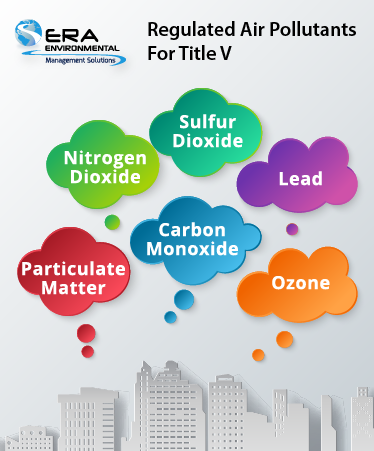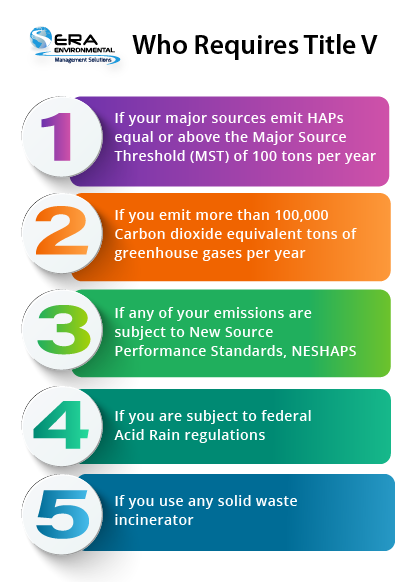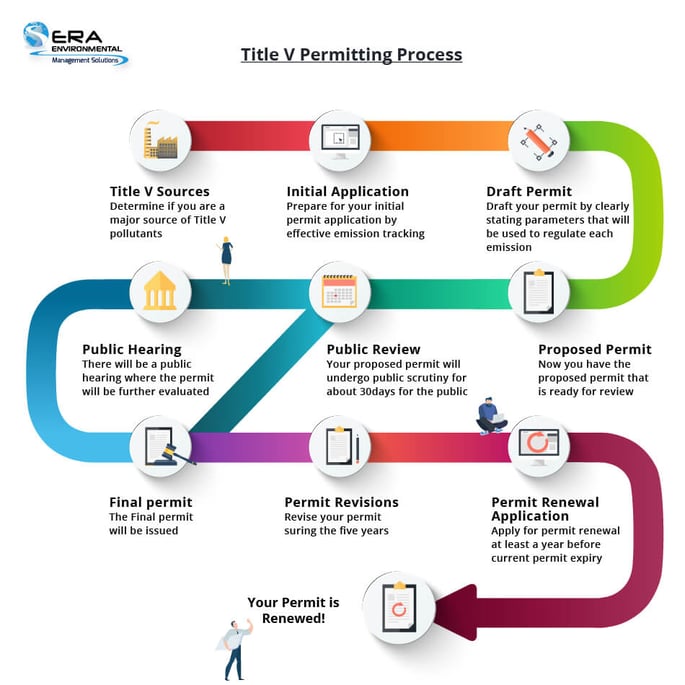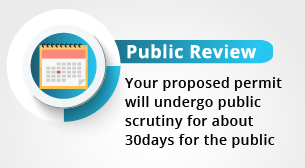Permitting is an effective way of enforcing Clean Air Act (CAA) regulations for various facilities. One of the major ways to enforce these regulations is through the Title V operating permit.
If you are looking for a rundown on everything Title V along with some helpful improvement and streamlining tips, this article covers the Title V Clean Air Act operating permit in detail.
What is a Title V Operating Permit?
This air permit is a requirement outlined by Title V of the CAA. It is an operating permit that is required by facilities that are major sources of air pollutants. These operating permits must be legally enforceable, and they are issued by permitting agencies to facilities that are sources of air pollution.
The permit may also be referred to as a part 70 permit because it is derived from 40 CFR part 70. The Clean Air Act Title V permit applies pollution control requirements from set regulations to pollution sources within your facility and are enforceable by both the EPA and the public.
Before exploring Title V permit thresholds and details, here is some background information on the permit and the regulation behind it.
Table of Contents (Click to jump to a topic)
What Did the Clean Air Act of 1970 Do?
What are Regulated Air Pollutants According to Title V?
What Was the Clean Air Act and Why Was It So Important?
The Clean Air Act is a federal law that governs air emissions from all sources. This law allows the EPA to determine National Ambient Air Quality Standards (NAAQs) that can help in protecting the public from the effects of harmful air pollutants. The act was initially passed to reduce air pollution down to NAAQS by 1975 and it was amended in 1990 to set new deadlines on NAAQS achievement.
The amendments also defined terms such as major sources of pollution as sources that have the potential to emit (PTE) 100 tons per year (tpy) of any air pollutant and area source as a stationary source that emits less than the limit to be defined as a major source. The CAA also set standards called maximum achievable control technology (MACT) standards that will be periodically reviewed. The main goal of this act is to reduce the amount of air pollution by setting rules and regulations for emissions.
|
Definitions |
|
|
Major Source |
Sources that have the potential to emit (PTE) air pollutants at levels above Major Source Thresholds (MST). |
|
Area Source |
Stationary source that emits less than the limit to be defined as a major source. |
What Did the Clean Air Act of 1970 Do?
The results of the CAA have been documented in detail and they clearly show an improvement in air quality over the years. The CAA has effectively lowered the levels of the six main pollutants that it regulates, namely: particles, lead (Pb), carbon monoxide (CO), nitrogen dioxide (NO2), sulfur dioxide (SO2) among other toxic pollutants. Between 1990 and 2017 air pollutant concentrations improved greatly:
- Carbon monoxide concentration improved by 77%.
- Lead improved by 80%.
- Sulfur dioxide improved by 88%.
- Nitrogen dioxide improved by 56% for and many others.
There are many more examples of CAA improvements. 41 areas that had unhealthy levels of carbon monoxide now all have CO levels that meet the health-based air quality standards. Lead pollution has dropped significantly because the use of lead in combustion engine fuel was phased out.
Damage to ecosystems has improved and there is less nutrient deterioration in the soil which improves crop yields. A study showed that since the CAA implementation, the crop and timber industry had an increased yield worth up to US$5.5 billion in revenue.
Overall, the CAA is improving public health and it is helpful for all industries to stay in compliance so that the environment and businesses can experience collective improvements. More statistics and graphs are provided in ERA’s Title V eBook.
What are Regulated Air Pollutants According to Title V?
The Title V air permit also regulates Volatile Organic Compounds (VOC) and Nitrogen oxides (NOx). VOCs and NOx are potentially harmful chemicals that exist in many solvents and petroleum that are also ozone precursors, and this makes them harmful to the environment.
Any pollutant that is limited under NAAQs is considered a regulated air pollutant. These include are shown in the graphic below.

Title V covers many hazardous air pollutants (HAPs). These are pollutants that have the potential to cause harm to humans in the form of cancers or other serious health effects. Examples include benzene which is found in gasoline and methylene chloride which is used as a solvent and paint stripper in many facilities.
If your facility emits one or more of the regulated air pollutants, then you must be mindful and include these in your Title V operating permit application. ERA’s environmental team can help you deduce the regulated air-polluting chemicals that your facility should report with the help of the Master Chemical List which has been developed over the years with various regulations in mind.
Who Requires Title V?
Facilities that are classified as major sources of pollutants require a Title V operating permit. The image below outlines the various conditions that your facility should meet to be subject to part 70 regulations. These conditions are clearly outlined and explained in ERA’s Title V Air Permits 101 blog.

Facilities that are classified as major sources of pollutants include:
- Facilities that produce 100tons per year (tpy) of pollutants require Title V permits, 50tpy of VOCs or NOx’s. In nonattainment areas and 25tpy in severe nonattainment areas.
|
Definition |
|
|
Nonattainment areas |
Areas that have worse air quality than the NAAQS. |
Other sources that require Title V permits include:
- Any facility that has a major source permit under the new source review permitting program. If you are a major source under the New Source Permitting program, then you are required to have a Title V. The new source review permitting program covers pollution from newly built or modified factories and ensures that new industries are clean and that there is a positive correlation between industry advancement and pollution control.
- Affected sources under acid rain rules. Acid rain rules cover sulfur dioxide (SO2) and nitrogen oxides (NOx) emissions, sets the maximum amounts of these gases that can be emitted such as setting the SO2 cap at 8.95 million tons which significantly reduces these emissions.
- Solid waste incineration units. These units are under section 129 and you must obtain a Title V permit regardless of the size of your facility if you fall under this category. These facilities include municipal waste combustors (large and small), hospital/medical/infectious waste incinerators, commercial and industrial solid waste incinerators, other solid waste incinerators and sewage sludge incinerators.
- Non-major Sources subject to National Emission Standards for Hazardous Air Pollutants (NESHAP) (MACT or GACT Standards). The types of facilities that belong to this group include hazardous waste combustors, mercury cell chlor-alkali plants, secondary lead smelters and carbon black production among many others, click here for a full list from the EPA.
- Some Synthetic Minor Sources subject to NESHAP Requirements such as chemical manufacturing.
- Non-major Sources subject to NESHAP and New Source Performance Standards (NSPS) Requirements such as municipal solid waste landfills.
Title V Permitting Exemptions.
Depending on your facility practices and activities, you may be exempt from the Title V operating permit. Some of the conditions for exemption include:
- If your facility has artificial emission limitation practices in place. If you limit your facility’s potential to emit (PTE) to below the Major Source Threshold (MST). The new limit must be enforceable. If your PTE is less than MST and your actual emissions are also below MST, then your facility is exempt from Title V. You must demonstrate the efforts that you are making to operate in a way that is limiting your emissions.
- If your emissions from the previous year were below 50% of Title V permit thresholds. You must be able to effectively demonstrate that your emissions were below 50% in the previous year. This means you must have effective record keeping and having environmental reporting software can help you with this.
- If you can demonstrate that your potential to emit (PTE) is below the Major Source Threshold, then you are exempt from Title V reporting. You must show that you are not a major source by submitting Form 500-e, form 400-A, and supporting documents that indicate this. ERA’s examples of supporting documents include emissions forecasted from usage records and chemical records. These processes can be done seamlessly with an environmental reporting module.
How Do You Obtain a Title V Air Permit?

If you have determined that you need a Title V permit, this section will walk you through how you can obtain your permit. To obtain the permit, you must apply using the application forms provided by your local agency or the government. The application must include:
- the emission sources,
- emission levels,
- more information to indicate the applicability of the permit.
Before filling out the application forms, you must compile all this information.
Firstly, you must properly identify the Title V standards that apply to your facility. This step is important because your facility may be subject to reporting for more than one standard. The standards include state implementation plans, federal implementation plans, acid rain requirements, and many more. You must cite and describe all the applicable standards.
The next step in compiling information for your Title V is determining the type of pollutants that are emitted by your facility and any exemptions that you may have. As mentioned in the section for Title V permit requirements, you must indicate which one of the listed pollutants you produce. Remember that if your emissions for a certain pollutant are below MST then these are insignificant and should not be included in your Title V.
You must also take note of other activities that generate significant air emissions. ERA recommends taking note of these activities that may include using portable generators or fire suppression systems and checking how these systems affect your Title V permit requirements.
You must also include extensive supporting documents that support all the regulations that apply to your facility. Supporting documents may include emissions calculations, the basis for emissions factors, historical throughput records and source test results. ERA’s document management module can help with effective storage and tracking of these documents enabling you to easily retrieve them to include them in your Title V permit application.
Sources that need operating permits are required to pay fees based on the actual number of emissions. Your local permitting authority will determine the fees associated with the permit. This fee is adjusted annually and is effective in a period from September 1st to August 31st.
After compiling all this information, you can proceed with your Title V application. The steps involved in the Title V application process are presented in the image below.
What Should Be Included in the Title V Application?
Your permitting agency will be able to provide you with the right forms for your facility. When it comes to your emissions information, you must be thorough. You must include:
- Information on the emissions of pollutants from major sources and fully describe these emissions and their sources so that your Title V permit thresholds can be verified. You must identify and describe in detail all the sources or emissions with enough details to show the requirements that are applicable but not so detailed that you subjugate yourself to extra emission tracking.
- The units of the emissions should be in tonnes per year (TPY) or emissions that have a yearly limit. These can be reported with all the other emissions that are included in that limit.
- You can also include supporting materials in the form of operating schedules and production rates.
- You are required to identify the equipment that you use to control air pollution and the activities that you have in place to monitor your compliance. This may also include showing the limitations of the operation of these sources if they affect emissions that are produced.
- You must cite the applicable Title V permit requirements and indicate how you are measuring and testing these emissions.
Other information that must be included in the application should clearly state how emissions will be monitored and reported. Remember to include explanations of how your facility is exempt from the standards if this applies to your facility.
How to Write a Title V Air Permit?
The most important aspect of the Title V application is writing it properly so that it clearly states the type of emissions from your facility, how you will manage them, and how these standards can be enforced. ERA has a detailed blog on how to write your Title V here. The overview of the process includes ensuring that your permit is practically enforceable.
|
Definition |
|
|
Practically Enforceable |
This means your permit should have no loopholes or omissions that can allow you to avoid noncompliance penalties. It must give the EPA capacity to hold you accountable for compliance. This is what makes the permit practically enforceable. |
To ensure that the permit is practically enforceable you must state:
- Who will be accountable for compliance?
- The types of emissions that your facility generates.
- The source of the emissions or where the emissions are generated along with control technology information.
- The set deadlines for when you will submit your reports.
- The form of testing and calculations that you will use to calculate your emissions.
- The frequency of emissions reporting on a rolling sum basis.
|
Definition |
|
|
Rolling Sum Basis |
This entails adding the current monthly emissions to the emissions from the previous eleven months. |
These processes are detailed in ERA’s Guide for Title V permits eBook.
If your facility is operating any pollution control equipment, it must be written explicitly in the permit. Include when and how long it will be operated. For example, if you have an incinerator, you must state when and how long it will be operational within the facility. Make sure you use clear statements to avoid leaving loopholes in your Title V operating permit.
Your data collection methods for emissions needs to be credible such as Continuous Emissions Monitoring Systems (CEMS), VOC content, or HAP calculations. You must ensure that you do not support one form of evidence over another; all forms of data collection must be presented with equal importance and you should use language that highlights this. To achieve this, stay away from ‘buster language’ such as: ‘the best method for tracking emission A is… or ‘data from source A is preferred because…’. Avoiding these statements will ensure that all your data collection methods are presented as equally valuable.
Streamlining Your Title V Air Permit
There are many state, federal, and regional regulations that may apply to your facility when it comes to Title V. This means some of the regulations may overlap or may be present in a different regulatory board with stricter guidelines.
To streamline your application, you must combine all the similar regulations and report for the stricter regulation. If you do this, that means you will remain in compliance with the less strict regulation without having to collect data separately for that regulation. For example, if one regulation sets your limit at 15 TPY and another one at 10 TPY, then you must report for the lower one because that is the stricter.
Make sure you use consistent units of measurement when you are streamlining your Title V and include the conversion factor in your Tier II application.
Further details and examples on streamlining are outlines in ERA’s Streamlining Your Title V Air Permit blog.
What Happens to Your Application After Submission?
After completing the Title V operating permit application forms you may submit your application for review by the authority responsible for issuing the permit in your region. The EPA has 45 days to review our permit application and the public and government have 30 days to scrutinize the permit before it is issued. After a thorough evaluation, the permit is issued.

Public Scrutiny of the Title V Operating Permit
Title V can be scrutinized by the public if they believe that the permit does not comply with the CAA. The public generally has 60 days to challenge the permit. The complaint can be emailed directly to the EPA and your permit may be re-evaluated. Therefore, you should make sure that your permit is in compliance with the CAA.
How to Monitor Your Title V Permit Requirements
After the permit is issued, it is important to continuously monitor your Title V requirements to ensure that you stay in compliance and avoid breaching your Title V permit. Various monitoring and analysis methods can be applied. The monitoring requirements can be used based on source type, and the method of selection for your monitoring approach. A few examples of monitoring approaches per pollutant are outlined below:
- Continuous Opacity Monitoring System (COMS), fuel monitoring, fuel records, and operating load restriction monitoring can be used for boilers fired by fuel oil, coal, natural gas, or stationary turbines. These monitoring methods are effective for SO2, NOx and particulate matter pollution.
- Leak detection and repair records, maintenance and cleaning records, visible emission observations, and water application rate, can be used to monitor fugitive sources such as large volume pumps, crushers, and unpaved roads within your facility. These methods are particularly useful for particulate matter.
- VOC and HAP content usage and VOC content monitoring can be used for VOC sources such as surface coating operations and lines. ERA has a master chemical list that records all the VOC and their associated regulations along with updates. This can be useful in calculating your air emissions for your Title V.
- Other VOC sources such as process vents that are controlled by flares or external floating roof tanks can be monitored by inspection and maintenance records and bypass valve inspections.
The EPA has more specific monitoring examples that can apply to your facility. Monitoring your emissions is how you ensure compliance with your permit and how you can deduce if you are exempt from certain pollutants.
What Is the Duration of the Title V Permit?
The EPA title V operating permit is valid for five years from the day it is issued. Longer permits are issued to facilities such as solid waste incineration units but they are also reviewed every five years to ensure compliance. Your facility is required to stay in compliance with the permit throughout its validity.
Renewing Your Title V Permit
Permit renewals undergo the same strict evaluations that the initial permits go through. You must renew your permit before your current one expires because permit expiry means that your facility loses its right to operate. Make sure you start preparing for renewal at least 12 months in advance. ERA recommends that you remember to check the regulations before applying that way you may stay up to date with the permit requirements. More information on permit renewal can be found in ERA’s Title V Air Permit Handbook.
How Can ERA Help You to Improve Your Title V Compliance?
There are various ways of tracking emissions mentioned above and these methods of monitoring require extensive record keeping. Having a centralized system that can help you with all these requirements can be a great advantage. Assuming your facility emits various regulated substances, the monitoring can become extensive and difficult to track. For example, some emissions are monitored using maintenance records and some are monitored using VOC content. These variables are different and presenting them in an excel sheet can be difficult. Employing software to assist with your air compliance can be a good way to ensure that all these variables are accurately addressed. Software such as ERA's environmental module has libraries of specific applicable regulations for all the different facilities within a company.
Get the Title V Guide Used by the EPA
If you want even more in-depth Title V guidance, we recommend you download a free copy of ERA's Title V Handbook. This guide was developed by our environmental scientists nearly a decade ago and has been updated continuously. The first edition of this guide was picked up by the EPA as an official training document for their staff - meaning you can feel secure knowing this data is top notch and reliable.
This Blog was Co-Authored By:



March 25, 2021
.jpg?width=250&name=Title-V-blog-CTA%20(1).jpg)
-1.jpg?width=250&name=Title-V-blog-CTA%20(1)-1.jpg)

Comments